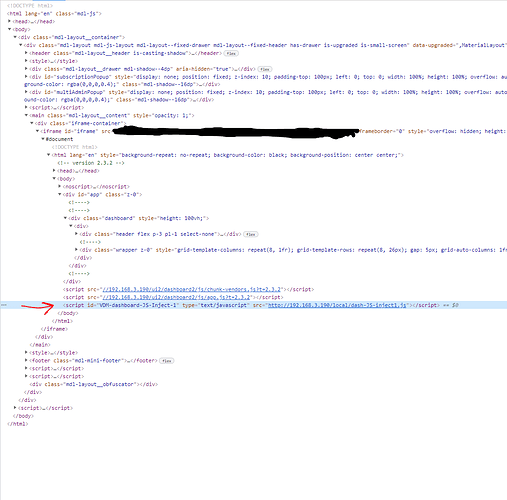Here's a different version which can double as a "temperature" tile when used as an attribute tile with the attribute "javascript" selected.
/**
* Copyright 2020 Markus Liljergren
*
* Licensed under the Apache License, Version 2.0 (the "License");
* you may not use this file except in compliance with the License.
* You may obtain a copy of the License at:
*
* http://www.apache.org/licenses/LICENSE-2.0
*
* Unless required by applicable law or agreed to in writing, software
* distributed under the License is distributed on an "AS IS" BASIS,
* WITHOUT WARRANTIES OR CONDITIONS OF ANY KIND, either express or implied.
* See the License for the specific language governing permissions and
* limitations under the License.
*/
import java.util.Date
metadata {
definition(name: "JavaScript Injector", namespace: "markus-li", author: "Markus Liljergren") {
capability "TemperatureMeasurement"
capability "Refresh"
command "clear"
command "setTemperature", [[name: "NUMBER", type: "NUMBER"]]
attribute "javascript", "string"
//attribute "javascriptLength", "number"
}
preferences {
input(name: "useDegreeC", type: "bool", title: "Use degrees C°? (Off for Degrees F°)", description: "Degrees C°", defaultValue: false, displayDuringSetup: false, required: false)
}
}
void updated() {
log.info "updated()"
refresh()
}
void refresh() {
log.info "refresh()"
/* EXAMPLE DATA for Dashboard */
String exampleCSS = '''
.modal {
font-family: -apple-system,BlinkMacSystemFont,avenir next,avenir,helvetica neue,helvetica,ubuntu,roboto,noto,segoe ui,arial,sans-serif;
display: none;
position: absolute;
background-color: yellow;
z-index: 9999;
top: 50%;
left: 50%;
width: 200px;
height: 200px;
}
.modal.is-open {
display: block;
}
.modal-close-btn {
background-color: grey;
}
#open-modal-btn {
position: absolute;
background-color: whitesmoke;
top: 10px;
left: 400px;
}
'''
/* Insert this EXAMPLE into the JSON for the Dashboard:
"customCSS": ".modal {\n font-family: -apple-system,BlinkMacSystemFont,avenir next,avenir,helvetica neue,helvetica,ubuntu,roboto,noto,segoe ui,arial,sans-serif;\n display: none;\n position: absolute;\n background-color: yellow;\n z-index: 9999;\n top: 50%;\n left: 50%;\n width: 200px;\n height: 200px;\n}\n\n.modal.is-open {\n display: block;\n}\n.modal-close-btn {\n background-color: grey;\n}\n\n#open-modal-btn {\nposition: absolute;\nbackground-color: whitesmoke;\ntop: 10px;\nleft: 400px;\n}",
"customJS": "\nvar body = document.getElementsByTagName(\"body\")[0];\nvar script = document.getElementById(\"inserted-body-script\");\nvar hasScript = script != null;\nif(!hasScript) {\nscript = document.createElement(\"script\");\nscript.setAttribute(\"id\", \"inserted-body-script\")\n}\n\nscript.type = \"text/javascript\";\n\nscript.src = \"https://cdn.jsdelivr.net/npm/micromodal/dist/micromodal.min.js\";\nif(!hasScript) {\nbody.appendChild(script);\n//alert(6);\n} else {\nMicroModal.show(\"modal-1\");\n//alert(10);\n}\n\nvar div = document.getElementById(\"inserted-body-html\");\nvar hasDiv = div != null;\nif(!hasDiv) {\ndiv = document.createElement(\"div\")\ndiv.setAttribute(\"id\", \"inserted-body-html\")\n}\n\ndiv.innerHTML = \"\";\nif(!hasDiv) {\nbody.prepend(div);\n}\nscript.onload = function() {\nMicroModal.init({debugMode: true});\nMicroModal.show(\"modal-1\");\nalert(2);\n}",
"customHTML": "<div id=\"open-modal-btn\"><a href=\"#\" data-micromodal-trigger=\"modal-1\">Open Modal</a></div><div id=\"modal-1\" class=\"modal\" aria-hidden=\"true\"><div tabindex=\"-1\" data-micromodal-close><div role=\"dialog\" aria-modal=\"true\" aria-labelledby=\"modal-1-title\" ><header><h2 id=\"modal-1-title\">Modal Title åäö</h2><button class=\"modal-close-btn\" aria-label=\"Close modal\" data-micromodal-close>Close Me</button><img /> <img /></header><div id=\"modal-1-content\">Modal Content</div></div></div></div>",
*/
// The above is just an ugly modal, but it showcases injecting JS and HTML from the JSON config...
// The below is too many characters, need to use the minified version below
String jsInjectionWithReInsert = '''
<svg style="display: none;" onload='
function lJ(callback) {
var urlParams = new URLSearchParams(window.location.search);
var xobj = new XMLHttpRequest();
xobj.overrideMimeType("application/json");
xobj.open("GET", window.location.pathname + "/layout", true);
xobj.withCredentials = true;
xobj.setRequestHeader("Authorization","Bearer " + urlParams.get("access_token"));
xobj.onreadystatechange = function () {
if (xobj.readyState == 4 && xobj.status == "200") {
callback(xobj.responseText);
}
};
xobj.send(null);
}
lJ(function(response) {
console.log(1);
var data = JSON.parse(response);
var body = document.getElementsByTagName("body")[0];
var div = document.getElementById("inserted-bootstrap-html");
var hasDiv = div != null;
if(!hasDiv) {
div = document.createElement("div");
div.setAttribute("id", "inserted-bootstrap-html");
}
div.innerHTML = data.customHTML;
if(!hasDiv) {
body.prepend(div);
}
var script = document.getElementById("inserted-bootstrap-script");
var hasScript = script != null;
if(script != null) {
script.remove();
}
script = document.createElement("script");
script.setAttribute("id", "inserted-bootstrap-script")
script.type = "text/javascript";
script.innerHTML = data.customJS;
body.prepend(script);
console.log("1E");
});
'></svg>'''
String jsInjectionWithoutReInsert = '''
<svg style="display: none;" onload='
function lJ(callback) {
var urlParams = new URLSearchParams(window.location.search);
var xobj = new XMLHttpRequest();
xobj.overrideMimeType("application/json");
xobj.open("GET", window.location.pathname + "/layout", true);
xobj.withCredentials = true;
xobj.setRequestHeader("Authorization","Bearer " + urlParams.get("access_token"));
xobj.onreadystatechange = function () {
if (xobj.readyState == 4 && xobj.status == "200") {
callback(xobj.responseText);
}
};
xobj.send(null);
}
lJ(function(response) {
var data = JSON.parse(response);
var body = document.getElementsByTagName("body")[0];
var div = document.getElementById("inserted-bootstrap-html");
if(div == null) {
div = document.createElement("div");
div.setAttribute("id", "inserted-bootstrap-html");
div.innerHTML = data.customHTML;
body.prepend(div);
}
var script = document.getElementById("inserted-bootstrap-script");
if(script == null) {
script = document.createElement("script");
script.setAttribute("id", "inserted-bootstrap-script");
script.type = "text/javascript";
script.innerHTML = data.customJS;
body.prepend(script);
}
});
'></svg>'''
// Minified version of the above
// https://javascript-minifier.com/
jsInjectionWithReInsert = '''
<svg style="display: none;" onload='
function lJ(e){var t=new URLSearchParams(window.location.search),n=new XMLHttpRequest;n.overrideMimeType("application/json"),n.open("GET",window.location.pathname+"/layout",!0),n.withCredentials=!0,n.setRequestHeader("Authorization","Bearer "+t.get("access_token")),n.onreadystatechange=function(){4==n.readyState&&"200"==n.status&&e(n.responseText)},n.send(null)}lJ(function(e){console.log(1);var t=JSON.parse(e),n=document.getElementsByTagName("body")[0],o=document.getElementById("inserted-bootstrap-html"),r=null!=o;r||(o=document.createElement("div")).setAttribute("id","inserted-bootstrap-html"),o.innerHTML=t.customHTML,r||n.prepend(o);var a=document.getElementById("inserted-bootstrap-script");null!=a&&a.remove(),(a=document.createElement("script")).setAttribute("id","inserted-bootstrap-script"),a.type="text/javascript",a.innerHTML=t.customJS,n.prepend(a),console.log("1E")});
'></svg>'''
jsInjectionWithoutReInsert = '''
<svg style="display: none;" onload='
function lJ(e){var t=new URLSearchParams(window.location.search),n=new XMLHttpRequest;n.overrideMimeType("application/json"),n.open("GET",window.location.pathname+"/layout",!0),n.withCredentials=!0,n.setRequestHeader("Authorization","Bearer "+t.get("access_token")),n.onreadystatechange=function(){4==n.readyState&&"200"==n.status&&e(n.responseText)},n.send(null)}lJ(function(e){var t=JSON.parse(e),n=document.getElementsByTagName("body")[0],r=document.getElementById("inserted-bootstrap-html");null==r&&((r=document.createElement("div")).setAttribute("id","inserted-bootstrap-html"),r.innerHTML=t.customHTML,n.prepend(r));var a=document.getElementById("inserted-bootstrap-script");null==a&&((a=document.createElement("script")).setAttribute("id","inserted-bootstrap-script"),a.type="text/javascript",a.innerHTML=t.customJS,n.prepend(a))});
'></svg>'''
String myJSMsg = "Refreshed(${(new Date()).format("ss")})${jsInjectionWithReInsert}"
sendEvent(name: "javascript", value: "${myJSMsg}", isStateChange: true)
//sendEvent(name: "javascriptLength", value: "${myJSMsg.length()}", isStateChange: true)
log.debug "Now: ${now()}, JS length: ${myJSMsg.length()}, Maximum is 1024"
}
void setTemperature(BigDecimal number) {
// This version doesn't reload the JS every time the temperature is updated
String jsInjectionWithoutReInsert = '''
<svg style="display: none;" onload='
function lJ(e){var t=new URLSearchParams(window.location.search),n=new XMLHttpRequest;n.overrideMimeType("application/json"),n.open("GET",window.location.pathname+"/layout",!0),n.withCredentials=!0,n.setRequestHeader("Authorization","Bearer "+t.get("access_token")),n.onreadystatechange=function(){4==n.readyState&&"200"==n.status&&e(n.responseText)},n.send(null)}lJ(function(e){var t=JSON.parse(e),n=document.getElementsByTagName("body")[0],r=document.getElementById("inserted-bootstrap-html");null==r&&((r=document.createElement("div")).setAttribute("id","inserted-bootstrap-html"),r.innerHTML=t.customHTML,n.prepend(r));var a=document.getElementById("inserted-bootstrap-script");null==a&&((a=document.createElement("script")).setAttribute("id","inserted-bootstrap-script"),a.type="text/javascript",a.innerHTML=t.customJS,n.prepend(a))});
'></svg>'''
// ° doesn't work for the Unit field
String unitDegree = "${(char)176}F"
if(useDegreeC == true) {
unitDegree = "${(char)176}C"
}
String myJSMsg = "<span class=\"jsi-temp\">$number <span class=\"small\"><span> $unitDegree </span></span></span>${jsInjectionWithoutReInsert}"
sendEvent(name: "temperature", value: "${number}", unit: unitDegree)
sendEvent(name: "javascript", value: "${myJSMsg}", unit: unitDegree)
//sendEvent(name: "javascriptLength", value: "${myJSMsg.length()}")
//log.debug "Now: ${now()}, JS length: ${myJSMsg.length()}, Maximum is 1024"
}
void clear() {
sendEvent(name: "javascript", value: "No JS", isStateChange: true)
}
void installed() {
log.info "Installed..."
refresh()
}
It can also be hidden by setting "display:none" in the CSS for the tile id of the virtual device with this driver. The JSON should then be updated with something like this and you can have another tile on top of it:
{
"rowSpan": 1,
"template": "attribute",
"col": 1,
"colSpan": 1,
"id": 13,
"row": 1,
"device": "1121",
"templateExtra": "javascript"
},
This is not a simple thing to use, but for those that want JS to work I assume the above isn't too hard. I know @spelcheck is working hard on getting this to be more user friendly. Looking forward to seeing the results!





